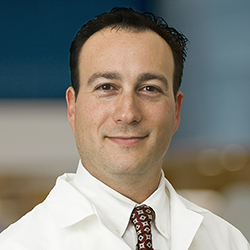Patent Ductus Arteriosus (PDA) Stenting
What is patent ductus arteriosus (PDA) stenting?
Patent ductus arteriosus (PDA) stenting is a procedure to help with blood flow in babies with certain heart conditions.
The ductus arteriosus is a small blood vessel near the heart. It connects the main artery for the lungs (pulmonary artery) to the main artery for the body (aorta). Normally, the ductus arteriosus is open before a baby is born, and it closes on its own soon after birth, usually within a few days.
Babies with certain heart defects may need their ductus arteriosus kept open. It may be a key path (or the only path) for blood to get to their lungs to pick up oxygen or to the rest of their body to deliver oxygen. Without it, the baby’s oxygen level can quickly get too low.
A stent is a small tube-shaped device designed to keep blood vessels open. An can place a stent inside the ductus arteriosus so blood can flow through. For babies who need it, PDA stenting can be lifesaving.
Who can benefit from PDA stenting?
Babies may need PDA stenting if blood cannot flow from their heart to their lungs or the rest of their body through typical paths. This may include babies with:
- Single-ventricle defects (only 1 pumping chamber in the heart that works, instead of the usual 2), such as:
- Double-inlet left ventricle
- Hypoplastic left heart syndrome
- Unbalanced atrioventricular septal defect
- Tricuspid atresia, sometimes called hypoplastic right heart syndrome
- Severe Ebstein’s anomaly
- Pulmonary atresia with intact ventricular septum
- Heterotaxy
- Tetralogy of Fallot
- Severe pulmonary stenosis
Often doctors can diagnose these conditions before birth (prenatally) using fetal echocardiography. This lets us plan the care your baby will need after birth.
The first step is usually to give your baby the medicine prostaglandin through an line. This medicine will keep the PDA open until your baby can receive a stent, usually within a week after they’re born.
What happens during PDA stenting?
Your baby will get their stent in 1 of our catheterization labs. They will have general anesthesia so they will sleep and will not feel anything anywhere in their body.
An interventional cardiologist will insert a small plastic tube (catheter) into a blood vessel in your child’s leg, neck or arm. Using this entry point, the doctor will guide the stent through your baby’s blood vessels to the ductus arteriosus. Then they will open the stent using a small balloon.
The process takes about 2 to 3 hours from the time your baby goes to sleep until they wake up.
For most babies, PDA stenting is a bridge until they can have further treatment — either surgery or another catheterization procedure — to repair their heart and improve their blood flow in a more lasting way.
What’s special about the experience at Seattle Children’s?
-
Leaders in pediatric catheterization
- Seattle Children’s does more PDA stenting procedures than any other hospital in our region — Washington, Alaska, Montana and Idaho. Our cardiologists are leaders in providing safe and effective diagnostic and for newborns.
- We were among the first hospitals in the country to begin using PDA stents, and we have many years of experience with this delicate procedure. Due to our expertise, we can place stents in babies with complex anatomy.
- Our pediatric cardiac anesthesia team has special training in giving anesthesia to children with heart problems to keep them safe and comfortable during and after their procedure.
- Your child’s team includes other experts from Seattle Children’s based on their needs, like doctors who specialize in newborns (neonatologists) or lung health (pulmonologists).
-
Advanced technology and methods
- The cardiac catheterization team provides care in 2 dedicated catheterization labs. Both have the latest technology to support the best care for your child.
- We use technology that provides the highest level of image clarity, including 3D imaging. This gives our doctors the clearest picture possible of your child’s heart. Clear imaging helps make your child’s procedure safer.
- Our imaging equipment is designed to image as “gently” as possible. It greatly lowers radiation exposure — by up to 75% over other kinds of catheterization equipment. This is most important for children who may need many procedures over their lifetime.
- After stenting, providers with special training and expertise will care for your baby in our Cardiac Intensive Care Unit.
- If PDA stenting isn’t the best procedure for your baby, our heart surgeons have a great deal of experience with another option — sewing a small tube (Blalock-Thomas-Taussig [BTT] shunt) in place to send blood where it’s needed.
-
Care from before birth into adulthood
- If your developing baby is diagnosed with a heart problem before birth, Seattle Children’s Fetal Care and Treatment Center team works closely with you and your family to plan and prepare for any care your baby may need, including cardiac catheterization procedures.
- Your team at Seattle Children’s will create a treatment plan that matches your child’s exact needs. Before PDA stenting, your child will have a so we can see their unique anatomy and provide care custom-made for them.
- Some of our patients keep seeing the Heart Center team at Seattle Children’s even after they become young adults. This is important because some patients still need care from experts in heart problems that start in childhood.
- We work closely with doctors at UW Medicine when our patients are ready to move into care with doctors who treat adults. Our special Adult Congenital Heart Disease Program, shared with the University of Washington, focuses on the long-term healthcare needs of people born with a heart condition.
-
Support for your whole family
- Whatever types of care your child needs, we will help your family through this experience. We will discuss your child’s condition and treatment options in ways you understand and involve you in every decision.
- Many of our Heart Center patients come from outside the Seattle area. We know you may be away from your home, community and usual support systems while dealing with your child’s illness. We are here to help meet your needs and those of your whole family during this time.
- Our Child Life specialists know how to help children understand their illnesses and treatments in ways that make sense for their age.
- Seattle Children’s has many resources, from financial to spiritual, to support your child and your family and make the journey as smooth as possible.
- Read more about the supportive care we offer.
-
Research to improve outcomes
- Seattle Children’s did some of the earliest studies showing that PDA stenting is a better option for most babies than open surgery to reroute blood flow with a BTT shunt.
- We are part of the Congenital Cardiac Research Collaborative, which is making a to study outcomes in children who get a PDA stent.
- In our research on outcomes, we look at survival rates and also other important measures, like neurodevelopment. Ongoing research helps us continue to refine care for congenital heart disease so every baby gets the best possible results.
- For more than 30 years, our cardiac catheterization team has been active in clinical trials testing new devices and treatments that may further reduce the risk and discomfort of treatment for children.
- Learn more about Heart Center research.
Scheduling an Appointment With the Heart Center
- If you would like a referral for Seattle Children’s Heart Center, talk to your child’s primary care provider.
- How to schedule an appointment at Seattle Children’s.
- If you already have an appointment, learn more about how to prepare.
- Learn about Heart Center resources such as useful links, videos and recommended reading for you and your family.
Leadership
-
Director, Cardiac Catheterization Laboratories; Attending Physician
Teams
Contact Us
Contact the Heart Center at 206-987-2015 for a referral, a second opinion or more information.
Providers, see how to refer a patient.
Related Links
Paying for Care
Learn about paying for care at Seattle Children’s, including insurance coverage, billing and financial assistance.


